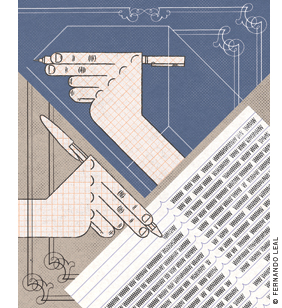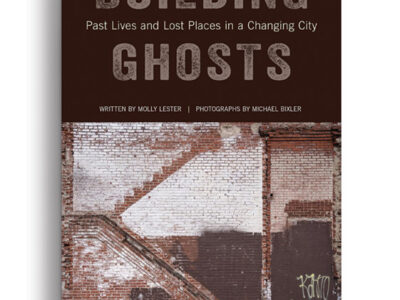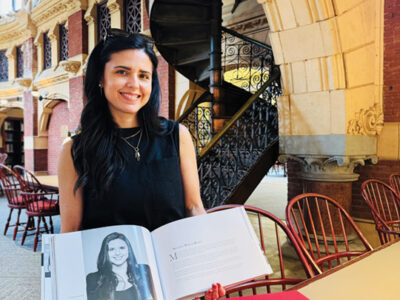
What good is language to an architect?
By Denise Scott Brown
Charles Seeger, philosopher of “musics,” believed that art, music, and architecture cannot be explained in writing, because words are linear and hide the essence of arts that are nonverbal and nonlinear. Stravinsky, too, when asked the meaning of a composition just played it again. But then what were Seeger and Stravinsky doing, and what am I doing writing words?
Moving from words to buildings is one of the great challenges of architecture. Architects once claimed that form should arise directly from function, without intermediary images derived from cultural or personal values. But that outlook is long gone. Today few call for design to be “value free,” only “value aware”; and we accommodate whatever helps us while designing, including our own personal and poetic associations—“that fountain should look like an Edwardian lady’s hat.” Feathers are sometimes the goad; at other times function. Creativity works idiosyncratically and a hat may initiate the process. Still, the client’s brief—a verbal statement—and the building’s social and visual context come first. They may provide merely a schedule of accommodations and relationships, or add qualitative instructions on character, performance, and context. Either way, they raise the problem of creating the physical from the verbal.
Architects’ words and sketches during the initial stages of design should be appraised only if they determine or crimp the efficiency of the building process or the quality and usability of its outcome. And of course the finished building should engage private and public meanings in those who encounter it, reminding us of more than just a hat. Perhaps T. S. Eliot was paralleling our tussles in architecture between form and function, art and science, private and public, linear and nonlinear when he described the “intolerable struggles between words and meaning” and wrote that “poetry does not matter” in a poem where it clearly did. To some people poetry is a missed vocation, a youthful intention, deflected through the choice of a more practical profession. To a few, the poetic may be rediscovered through that profession. Lewis Thomas, for example, studied medicine and worked much of his life in research, but he also returned to his first love and wrote poetically about molecular biology. Similarly, the architect and planner Arthur Holden published a book of sonnets on zoning.
How do you learn and teach architectural writing? I learned it in primary and secondary school, then on my own with help from friends like Charles Seeger; and, although I would not dare teach the personal and poetic, I am accustomed to helping interns learn to write everyday prose. A few arrive with this ability but most seem not to have learned it in either their liberal arts or professional education. I gather that some professional schools (engineering, for example) run in-house courses in expository writing, having discovered that the last place they will find this teaching is in university English departments. I tell young architects that building an argument is like building a building. You cannot just throw thoughts at a subject; there must be a logic and pattern to the development of ideas. This then gets translated into structures and substructures, with the alteration of one part requiring the restabilization of the whole. Student architects are sometimes told, if you can write, you can draw. I reverse the argument: if you can draw you can write (not poetry, but good working prose).
There is also the relationship between words and pictures. The slide lecture is the native habitat of architects. Used for representing, explaining and proselytizing, selecting pictures to make a point is a curator’s art. Yet comparing pictures to tell a story—the staple of art and architectural lecturing—can have an unintended effect on a designer and powerfully influence the act of designing. You see something you love; it is so beautiful that somehow you must use it, but you do not know why. Or two slides go beautifully together, but what is their point? It is the same with photographing architecture. If you stop to think why you need the picture it may be gone. So take it and think later. As the lecture proceeds, you work out why you need it. And sometimes the serendipitous slide or the illogical combination starts a new train of thought. Perhaps 10 years later it may appear in a design.
Ultimately, design’s relation to the world of words is trumped by its alliance to drawing, which is so central to visualizing and conceiving. An architectural drawing is not an end in itself but a tool. The end is usually a building, although architectural drawing may also express a philosophy or wage a polemic. In designing, there is an oscillation between hand, eye, and mind. At first, the mind tells the hand; later, as in action painting, the hand may inform the mind. To me, the most revealing drawings are those made at the outset of a project. Early sketches record a search for essence. They depict moments of insight and points of resolution during an architectural odyssey. Done serially in periods of intense concentration, they record sequences of high creativity in the design process, hence their vigor and spontaneity. Something in the crude first sketch and in the act of drawing (even doodling) helps develop the idea further. The elusive essence may be discovered accidentally, perhaps in a pile of rejects. This “summary drawing” is often a truer representation of the character of the building than those produced later and in greater detail. Not considered self-consciously as art, it achieves its artistry by indirection.
The flow between hand, eye, and mind is different in writing and designing, but in each there is a bond with an instrument—pen, pencil, drafting tool or typing keys. This bond, which is tied by artists to their creativity, is evident in architectural drawings of different eras and perhaps in the resultant architecture too. And it is changing once again with the computer. Then there is music. While writing or designing, I may find regeneration in a third way of relating hand, eye, and mind—by pausing to play the piano. Bob Venturi, my partner in work and life, treats music as flowing architecture. He compares its rhythms with building rhythms. He sees the dissonances of Beethoven as mannerist; he is awed by his musical monumentality and intrigued by his juxtaposition of the calico and the tragic. Beethoven helps Bob where the latest archimag cannot. Can the nonlinear arts help each other? Can we best describe a building by writing music?
Or a poem? My argument with Seeger is that words too, especially poetry, have vast nonlinear dimensions through the layers of association they evoke, and that these can be primary sources for creativity in architecture. I owe so much to this dear friend who beat paths between words and music years before I was born, then mentored my attempts to do the same in architecture.
Then forget words. Creative cycles call for reading, thinking, impassioning, then sleeping and opening a new book. There need be no preconceptions. The world can start again on a white page. But as the design evolves, there is room for all we have ever seen or read. The words return in altered form.
Denise Scott Brown GCP’60 GAr’65 is a principal architect at Venturi, Scott Brown and Associates. This essay is adapted from Having Words, published in 2009 by the Architectural Association London.




